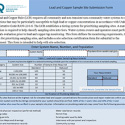Starting October 16, 2024, any water systems which exceeds the action level for lead is required to issue a tier 1 public notice within 24 hours. The Division of Drinking Water recommends water systems prepare ahead of time to have everything in place in case a public notice for lead is required.
In 1991 the Environmental Protection Agency (EPA) published a regulation known as the Lead and Copper Rule (LCR). The LCR established a requirement for public drinking water systems classified as either community or non-community non-transient to routinely monitor for lead and copper.
Also identified in the LCR are action levels for lead and copper. An action level is a threshold above which a water system must take steps to ensure safety and protect public health. For lead and copper, the action level is deemed to have been exceeded when more than 10% of the samples tested during a collection period show concentrations at or above the 15 ppb for lead and 1300 ppb for copper and is called a 90th percentile exceedance.
Lead and Copper Compliance Steps
Step 1: Sample Site Plan
Develop, submit, and maintain an LCR Sample Site Plan.
Step 2: Routine Sampling
Find out how, when, and where to collect and submit lead and copper samples.
Step 3: Results
Learn how to use the results workflow chart.
Steps 4 & 5: Consumer and Public Notification
Find out about public communication requirements.





